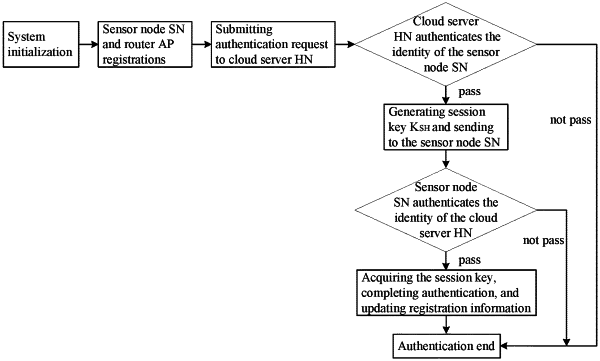| CPC H04W 12/02 (2013.01) [H04L 63/0869 (2013.01); H04W 84/18 (2013.01)] | 8 Claims |

|
1. A privacy protection authentication method based on a wireless body area network, comprising:
S1, initializing a cloud server HN;
S2, submitting a registration request in a secure channel to a super administrator SA by a user through a device, and returning registration information to the device through the secure channel by the super administrator after computational processing;
S3, submitting an authentication request to the cloud server HN, accessing the registration information from a memory and sending the registration information after being added with verification parameters to the cloud server HN, by the user through the device;
S4, determining a session key KSH for the device and the cloud server HN, after the device and the cloud server HN both complete authentications; and
S5, updating the registration information in the memory;
wherein the device and the cloud server HN transmit information EMS through a wireless public channel, the information EMS is relayed through a router AP, the router AP is responsible for relaying and forwarding the information EMS, and an identity idp of the router AP is added to or removed from the relayed information EMS; and
wherein the S2 specifically comprises:
S2.1, transmitting information with the super administrator SA through the secure channel by the user after installing a healthcare monitoring device;
S2.2, sending the registration request to the super administrator SA through the secure channel by the user;
S2.3, generating current time stamp Tj and storing the current time stamp Tj in the cloud server HN, by the super administrator SA after receiving the registration request; setting an identity idj and a random integer aj for a sensor node SN of the healthcare monitoring device by the super administrator SA, calculating public values xj and yj between the cloud server HN and the sensor node SN of the healthcare monitoring device and a secret value MNj between the cloud server HN and the sensor node SN of the healthcare monitoring device, and sending the registration information to the sensor node SN of the healthcare monitoring device through the secure channel;
S2.4, storing the registration information {idj, xj, yj, MNj} to the memory by the sensor node SN of the healthcare monitoring device after receiving the registration information;
S2.5, setting an identity idp for a router AP by the super administrator SA, and storing the identity idp in both the router AP and the cloud server HN; and
S2.6, generating a device challenge value Chaj based on a physical unclonable function (PUF), calculating a response value Resj, calculating a secret value STj of the sensor node SN and storing Chaj, Resj, STj in the memory, by the sensor node SN of the healthcare monitoring device.
|